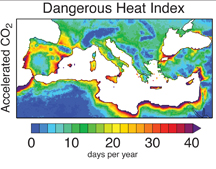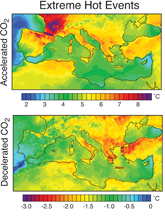
| RELATED INFO |
| * Purdue Climate Change Research Center |
| * Diffenbaugh Research Group |

June 14, 2007
Reduced greenhouse gas emissions required to avoid dangerous increases in heat stress, researchers say
WEST LAFAYETTE, Ind. - |
The study also showed a reduction in greenhouse gas emissions could reduce the intensification of dangerously hot days projected in the scenario by up to 50 percent.
"Rare events today, like the 2003 heat wave in Europe, will become much more common as greenhouse gas concentrations increase," said Noah Diffenbaugh, the Purdue assistant professor of earth and atmospheric sciences who led the study. "The frequency at which that scale of event occurs at high greenhouse gas concentrations is staggering. Rare events become the norm, and the extreme events of the future are unprecedented in their severity."
A 2003 heat wave led to 15,000 deaths in France and almost 3,000 in Italy. The researchers found that global warming causes summer temperatures to dramatically exceed the range that was correlated with the increased number of deaths.
"The thresholds of the 2003 event are substantially exceeded in the future in both of our research scenarios," said Diffenbaugh, who is a member of Purdue's Climate Change Research Center. "This research is about understanding the response to different emissions levels. We find that decreases in greenhouse gas emissions greatly reduce the impact, but we see negative effects even with reduced emissions. Technological and behavioral changes that are made now will have a big influence on what actually happens in the future."
 |
In addition to the human health risks, extremely high temperatures could impact the economy of this region, which includes metropolitan areas such as Rome, Paris and Barcelona, said Jeremy Pal, co-researcher and associate professor of civil and environmental engineering at Loyola Marymount University.
The study covered the entire Mediterranean area, which includes 21 countries in Europe, Africa and Asia. Major cities covered in the study include: Prague, Zurich, Bucharest, Athens, Istanbul, Tel Aviv, Cairo, Algiers and Casablanca.
"When high temperature extremes increase, it could have significant negative impacts on human health, water resources, agriculture and energy demand," Pal said.
The results of the study, which originated at the International Centre for Theoretical Physics in Trieste, Italy, will be published in the Friday (June 15) issue of Geophysical Research Letters.
In addition to Diffenbaugh and Pal, Filippo Giorgi of the International Centre for Theoretical Physics and Xuejie Gao of the National Climate Center in Beijing are co-authors of the paper. The researchers used a supercomputer in the National Climate Center in Beijing to run the climate model.
The model offers a resolution of 20 kilometers, about 12.5 miles, and is believed to have the highest spatial resolution available for the Mediterranean region. Much like increased resolution in a photo makes a clearer picture and allows one to zoom in without blurring the image, the powerful resolution of the climate model allows researchers to gather detailed information about particular areas.
Giorgi, who is head of the Earth System Physics Section of the International Centre for Theoretical Physics, said the Mediterranean is of interest because it is one of the most susceptible areas to climate changes - both climatically and socially.
"In the global warming scenario, there is more warming and drying in the Mediterranean than in other regions of the world, which makes the Mediterranean a climate change 'hotspot,'" Giorgi said. "The Mediterranean also is a very vulnerable region to climate change in terms of the impacts to the way of life of those who live there."
The researchers found that this warming and reduced precipitation contribute to a preferential warming of the hottest days of the year.
"We found that the hottest days of the year, or the 'hot tail,' warm more than the typical summer days warm," Diffenbaugh said. "One might expect that an average warming of four degrees would equate to each day warming by four degrees, but in fact the hottest days warm quite a bit more."
This is due, in large part, to a surface moisture feedback. The surface gets dryer as it gets hotter and the dry soil leads to less moisture in the area and less evaporative cooling. The locations of intensified warming on hottest days of the year matched the locations where surface drying occurred, Diffenbaugh said.
With the projected shift to more severe temperatures, the daily temperatures currently found in the hottest two weeks of the summer instead are found in the coldest two weeks of the summer in the future climate scenario, Diffenbaugh said.
"The hottest temperatures we are used to experiencing will become the normal temperatures of the summer, and the hot periods will be magnified," Diffenbaugh said. "Take Paris: If we look at the temperatures that occurred there during the heat wave in 2003, when 15,000 people died, those temperatures are exceeded a couple dozen times every year in the future projection. That means that severe heat waves, such as those rare events that have occurred in the past couple of years, are likely to become far more common."
The study used the National Weather Service Heat Index in the analysis of the heat stress response to increasing greenhouse gas concentrations. The researchers found that areas most likely to face substantial increases in the dangerous heat index were concentrated largely in coastal areas.
"Coastal regions were more affected than inland regions, which is of particular importance because many large cities in the Mediterranean are on the coast," Giorgi said. "This is the first time this amplification signal over coastal areas could be seen and quantified. Coastal regions are particularly vulnerable because they will likely be affected by other important climate change related stresses, such as a rising sea level."
Diffenbaugh said without the high resolution of the climate model, the researchers would not have been able to identify the coastal effects.
"This underscores the importance of advancing our technology and examining a number of scenarios in great detail," he said. "If we want to quantify the risks associated with climate change, it is critical to understand the local and regional impacts as well as the global impacts."
For the study's standard future scenario, the research group used a commonly accepted emissions scenario from the Intergovernmental Panel on Climate Change that assumes greenhouse gas emissions continue to increase exponentially. The reduced emissions scenario incorporated a reduction in population growth and greater environmental concern, Diffenbaugh said.
The researchers are currently using the high-resolution model to further evaluate the effects that increased temperatures and surface drying could have on agriculture and energy and water resources.
This research was funded by the Italy-USA collaborative agreement on climate change research and in part by the National Science Foundation.
The Purdue Climate Change Research Center is affiliated with Purdue's Discovery Park. The center promotes and organizes research and education on global climate change and studies its impact on agriculture, natural ecosystems and society. It was established in 2004 to support Purdue in research and education on regional scale climate change, its impacts and mitigation, and adaptation strategies. The center serves as a hub for a range of activities beyond scientific research, including teaching, public education and the development of public policy recommendations.
Writer: Elizabeth K. Gardner, (765) 494-2081, ekgardner@purdue.edu
Additional Media Contact: Christine Nangle, assistant director of communications and media for Loyola Marymount University, (310) 338-2389, cnangle@lmu.edu
Sources: Noah Diffenbaugh, + 39 040 2240 579 (Central European Time Zone), diffenbaugh@purdue.edu
Jeremy Pal, +39 040 224 0579 (Central European Time Zone, (310) 633-0077, jpal@lmu.edu
Filippo Giorgi, +39 040 2240 425 (Central European Time Zone), Giorgi@ictp.it
Purdue News Service: (765) 494-2096; purduenews@purdue.edu
IMAGE CAPTION:
This image represents intensification of dangerous heat stress in the 21st century. The color contours show the expected intensification of dangerous heat index days given accelerating increases in greenhouse gas concentrations. (Purdue University image/Diffenbaugh Laboratory)
A publication-quality image is available at https://www.purdue.edu/uns/UNS/images/+2007/diffenbaugh-heat2.jpg
IMAGE CAPTION:
This image illustrates heat stress in the 21st century for two greenhouse gas emissions scenarios. The top panel shows the expected intensification of the severity of extreme hot days given accelerating increases in greenhouse gas concentrations. The bottom panel shows the expected decrease in intensification associated with decelerated increases in greenhouse gas concentrations. (Purdue University image/Diffenbaugh Laboratory)
A publication-quality image is available at https://www.purdue.edu/uns/UNS//images/+2007/diffenbaugh-heat.jpg
Heat Stress Intensification in the Mediterranean Climate Change Hotspot
Noah S. Diffenbaugh, Jeremy S. Pal,
Filippo Giorgi and Xuejie Gao
We find that elevated greenhouse gas concentrations dramatically increase heat stress risk in the Mediterranean region, with the occurrence of hot extremes increasing by 200 to 500% throughout the region. This heat stress intensification is due to preferential warming of the hot tail of the daily temperature distribution, with 95th percentile maximum and minimum temperature magnitude increasing more than 75th percentile magnitude. This preferential warming of the hot tail is dictated in large part by a surface moisture feedback, with areas of greatest warm-season drying showing the greatest increases in hot temperature extremes. Fine-scale topographic and humidity effects help to further dictate the spatial variability of the heat stress response, with increases in dangerous Heat Index magnified in coastal areas. Further, emissions deceleration substantially mitigates heat stress intensification throughout the Mediterranean region, implying that emissions reductions could reduce the risk of increased heat stress in the coming decades.
To the News Service home page
If you have trouble accessing this page because of a disability, please contact Purdue News Service at purduenews@purdue.edu.
